Peng-Tao Jiang
HyperMotion: DiT-Based Pose-Guided Human Image Animation of Complex Motions
May 29, 2025Abstract:Recent advances in diffusion models have significantly improved conditional video generation, particularly in the pose-guided human image animation task. Although existing methods are capable of generating high-fidelity and time-consistent animation sequences in regular motions and static scenes, there are still obvious limitations when facing complex human body motions (Hypermotion) that contain highly dynamic, non-standard motions, and the lack of a high-quality benchmark for evaluation of complex human motion animations. To address this challenge, we introduce the \textbf{Open-HyperMotionX Dataset} and \textbf{HyperMotionX Bench}, which provide high-quality human pose annotations and curated video clips for evaluating and improving pose-guided human image animation models under complex human motion conditions. Furthermore, we propose a simple yet powerful DiT-based video generation baseline and design spatial low-frequency enhanced RoPE, a novel module that selectively enhances low-frequency spatial feature modeling by introducing learnable frequency scaling. Our method significantly improves structural stability and appearance consistency in highly dynamic human motion sequences. Extensive experiments demonstrate the effectiveness of our dataset and proposed approach in advancing the generation quality of complex human motion image animations. Code and dataset will be made publicly available.
MagicTryOn: Harnessing Diffusion Transformer for Garment-Preserving Video Virtual Try-on
May 28, 2025Abstract:Video Virtual Try-On (VVT) aims to simulate the natural appearance of garments across consecutive video frames, capturing their dynamic variations and interactions with human body motion. However, current VVT methods still face challenges in terms of spatiotemporal consistency and garment content preservation. First, they use diffusion models based on the U-Net, which are limited in their expressive capability and struggle to reconstruct complex details. Second, they adopt a separative modeling approach for spatial and temporal attention, which hinders the effective capture of structural relationships and dynamic consistency across frames. Third, their expression of garment details remains insufficient, affecting the realism and stability of the overall synthesized results, especially during human motion. To address the above challenges, we propose MagicTryOn, a video virtual try-on framework built upon the large-scale video diffusion Transformer. We replace the U-Net architecture with a diffusion Transformer and combine full self-attention to jointly model the spatiotemporal consistency of videos. We design a coarse-to-fine garment preservation strategy. The coarse strategy integrates garment tokens during the embedding stage, while the fine strategy incorporates multiple garment-based conditions, such as semantics, textures, and contour lines during the denoising stage. Moreover, we introduce a mask-aware loss to further optimize garment region fidelity. Extensive experiments on both image and video try-on datasets demonstrate that our method outperforms existing SOTA methods in comprehensive evaluations and generalizes to in-the-wild scenarios.
Any-to-Bokeh: One-Step Video Bokeh via Multi-Plane Image Guided Diffusion
May 27, 2025Abstract:Recent advances in diffusion based editing models have enabled realistic camera simulation and image-based bokeh, but video bokeh remains largely unexplored. Existing video editing models cannot explicitly control focus planes or adjust bokeh intensity, limiting their applicability for controllable optical effects. Moreover, naively extending image-based bokeh methods to video often results in temporal flickering and unsatisfactory edge blur transitions due to the lack of temporal modeling and generalization capability. To address these challenges, we propose a novel one-step video bokeh framework that converts arbitrary input videos into temporally coherent, depth-aware bokeh effects. Our method leverages a multi-plane image (MPI) representation constructed through a progressively widening depth sampling function, providing explicit geometric guidance for depth-dependent blur synthesis. By conditioning a single-step video diffusion model on MPI layers and utilizing the strong 3D priors from pre-trained models such as Stable Video Diffusion, our approach achieves realistic and consistent bokeh effects across diverse scenes. Additionally, we introduce a progressive training strategy to enhance temporal consistency, depth robustness, and detail preservation. Extensive experiments demonstrate that our method produces high-quality, controllable bokeh effects and achieves state-of-the-art performance on multiple evaluation benchmarks.
Photography Perspective Composition: Towards Aesthetic Perspective Recommendation
May 27, 2025Abstract:Traditional photography composition approaches are dominated by 2D cropping-based methods. However, these methods fall short when scenes contain poorly arranged subjects. Professional photographers often employ perspective adjustment as a form of 3D recomposition, modifying the projected 2D relationships between subjects while maintaining their actual spatial positions to achieve better compositional balance. Inspired by this artistic practice, we propose photography perspective composition (PPC), extending beyond traditional cropping-based methods. However, implementing the PPC faces significant challenges: the scarcity of perspective transformation datasets and undefined assessment criteria for perspective quality. To address these challenges, we present three key contributions: (1) An automated framework for building PPC datasets through expert photographs. (2) A video generation approach that demonstrates the transformation process from suboptimal to optimal perspectives. (3) A perspective quality assessment (PQA) model constructed based on human performance. Our approach is concise and requires no additional prompt instructions or camera trajectories, helping and guiding ordinary users to enhance their composition skills.
Enhancing Visual Grounding for GUI Agents via Self-Evolutionary Reinforcement Learning
May 18, 2025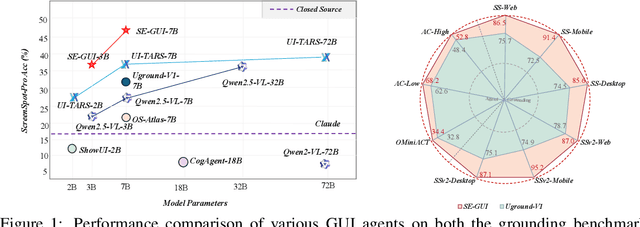
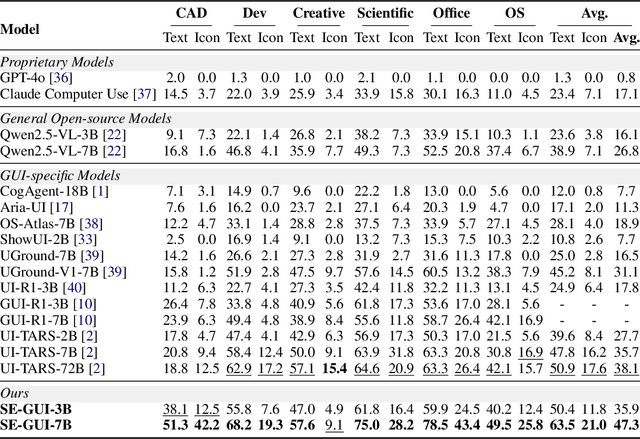
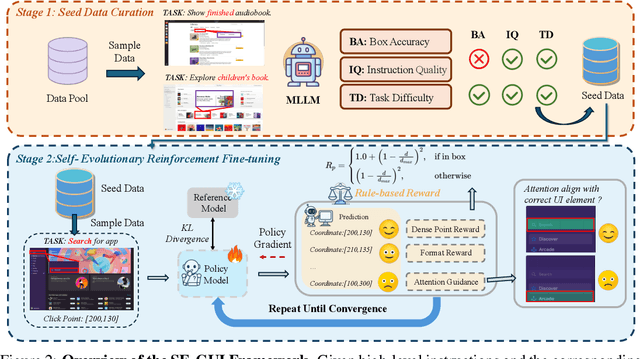

Abstract:Graphical User Interface (GUI) agents have made substantial strides in understanding and executing user instructions across diverse platforms. Yet, grounding these instructions to precise interface elements remains challenging, especially in complex, high-resolution, professional environments. Traditional supervised finetuning (SFT) methods often require large volumes of diverse data and exhibit weak generalization. To overcome these limitations, we introduce a reinforcement learning (RL) based framework that incorporates three core strategies: (1) seed data curation to ensure high quality training samples, (2) a dense policy gradient that provides continuous feedback based on prediction accuracy, and (3) a self evolutionary reinforcement finetuning mechanism that iteratively refines the model using attention maps. With only 3k training samples, our 7B-parameter model achieves state-of-the-art results among similarly sized models on three grounding benchmarks. Notably, it attains 47.3\% accuracy on the ScreenSpot-Pro dataset, outperforming much larger models, such as UI-TARS-72B, by a margin of 24.2\%. These findings underscore the effectiveness of RL-based approaches in enhancing GUI agent performance, particularly in high-resolution, complex environments.
M2N2V2: Multi-Modal Unsupervised and Training-free Interactive Segmentation
Mar 20, 2025Abstract:We present Markov Map Nearest Neighbor V2 (M2N2V2), a novel and simple, yet effective approach which leverages depth guidance and attention maps for unsupervised and training-free point-prompt-based interactive segmentation. Following recent trends in supervised multimodal approaches, we carefully integrate depth as an additional modality to create novel depth-guided Markov-maps. Furthermore, we observe occasional segment size fluctuations in M2N2 during the interactive process, which can decrease the overall mIoU's. To mitigate this problem, we model the prompting as a sequential process and propose a novel adaptive score function which considers the previous segmentation and the current prompt point in order to prevent unreasonable segment size changes. Using Stable Diffusion 2 and Depth Anything V2 as backbones, we empirically show that our proposed M2N2V2 significantly improves the Number of Clicks (NoC) and mIoU compared to M2N2 in all datasets except those from the medical domain. Interestingly, our unsupervised approach achieves competitive results compared to supervised methods like SAM and SimpleClick in the more challenging DAVIS and HQSeg44K datasets in the NoC metric, reducing the gap between supervised and unsupervised methods.
DepthMaster: Taming Diffusion Models for Monocular Depth Estimation
Jan 05, 2025



Abstract:Monocular depth estimation within the diffusion-denoising paradigm demonstrates impressive generalization ability but suffers from low inference speed. Recent methods adopt a single-step deterministic paradigm to improve inference efficiency while maintaining comparable performance. However, they overlook the gap between generative and discriminative features, leading to suboptimal results. In this work, we propose DepthMaster, a single-step diffusion model designed to adapt generative features for the discriminative depth estimation task. First, to mitigate overfitting to texture details introduced by generative features, we propose a Feature Alignment module, which incorporates high-quality semantic features to enhance the denoising network's representation capability. Second, to address the lack of fine-grained details in the single-step deterministic framework, we propose a Fourier Enhancement module to adaptively balance low-frequency structure and high-frequency details. We adopt a two-stage training strategy to fully leverage the potential of the two modules. In the first stage, we focus on learning the global scene structure with the Feature Alignment module, while in the second stage, we exploit the Fourier Enhancement module to improve the visual quality. Through these efforts, our model achieves state-of-the-art performance in terms of generalization and detail preservation, outperforming other diffusion-based methods across various datasets. Our project page can be found at https://indu1ge.github.io/DepthMaster_page.
Learning Adaptive Lighting via Channel-Aware Guidance
Dec 02, 2024



Abstract:Learning lighting adaption is a key step in obtaining a good visual perception and supporting downstream vision tasks. There are multiple light-related tasks (e.g., image retouching and exposure correction) and previous studies have mainly investigated these tasks individually. However, we observe that the light-related tasks share fundamental properties: i) different color channels have different light properties, and ii) the channel differences reflected in the time and frequency domains are different. Based on the common light property guidance, we propose a Learning Adaptive Lighting Network (LALNet), a unified framework capable of processing different light-related tasks. Specifically, we introduce the color-separated features that emphasize the light difference of different color channels and combine them with the traditional color-mixed features by Light Guided Attention (LGA). The LGA utilizes color-separated features to guide color-mixed features focusing on channel differences and ensuring visual consistency across channels. We introduce dual domain channel modulation to generate color-separated features and a wavelet followed by a vision state space module to generate color-mixed features. Extensive experiments on four representative light-related tasks demonstrate that LALNet significantly outperforms state-of-the-art methods on benchmark tests and requires fewer computational resources. We provide an anonymous online demo at https://xxxxxx2025.github.io/LALNet/.
Learning Differential Pyramid Representation for Tone Mapping
Dec 02, 2024



Abstract:Previous tone mapping methods mainly focus on how to enhance tones in low-resolution images and recover details using the high-frequent components extracted from the input image. These methods typically rely on traditional feature pyramids to artificially extract high-frequency components, such as Laplacian and Gaussian pyramids with handcrafted kernels. However, traditional handcrafted features struggle to effectively capture the high-frequency components in HDR images, resulting in excessive smoothing and loss of detail in the output image. To mitigate the above issue, we introduce a learnable Differential Pyramid Representation Network (DPRNet). Based on the learnable differential pyramid, our DPRNet can capture detailed textures and structures, which is crucial for high-quality tone mapping recovery. In addition, to achieve global consistency and local contrast harmonization, we design a global tone perception module and a local tone tuning module that ensure the consistency of global tuning and the accuracy of local tuning, respectively. Extensive experiments demonstrate that our method significantly outperforms state-of-the-art methods, improving PSNR by 2.58 dB in the HDR+ dataset and 3.31 dB in the HDRI Haven dataset respectively compared with the second-best method. Notably, our method exhibits the best generalization ability in the non-homologous image and video tone mapping operation. We provide an anonymous online demo at https://xxxxxx2024.github.io/DPRNet/.
Unsupervised Modality Adaptation with Text-to-Image Diffusion Models for Semantic Segmentation
Oct 29, 2024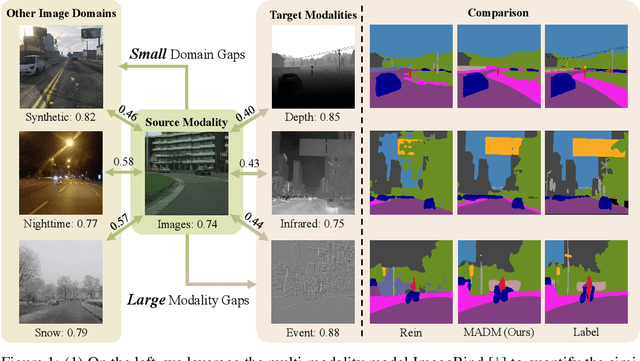
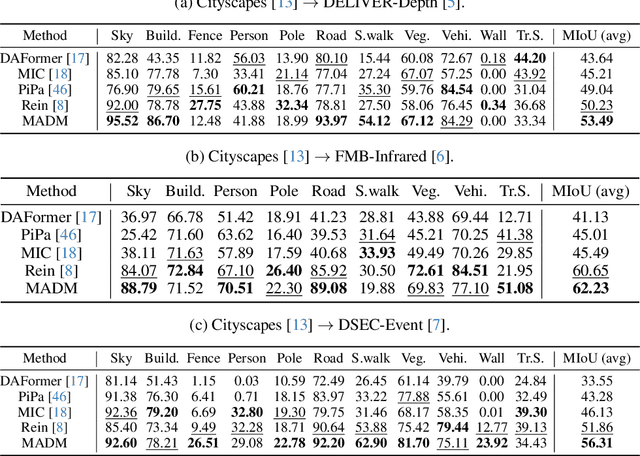


Abstract:Despite their success, unsupervised domain adaptation methods for semantic segmentation primarily focus on adaptation between image domains and do not utilize other abundant visual modalities like depth, infrared and event. This limitation hinders their performance and restricts their application in real-world multimodal scenarios. To address this issue, we propose Modality Adaptation with text-to-image Diffusion Models (MADM) for semantic segmentation task which utilizes text-to-image diffusion models pre-trained on extensive image-text pairs to enhance the model's cross-modality capabilities. Specifically, MADM comprises two key complementary components to tackle major challenges. First, due to the large modality gap, using one modal data to generate pseudo labels for another modality suffers from a significant drop in accuracy. To address this, MADM designs diffusion-based pseudo-label generation which adds latent noise to stabilize pseudo-labels and enhance label accuracy. Second, to overcome the limitations of latent low-resolution features in diffusion models, MADM introduces the label palette and latent regression which converts one-hot encoded labels into the RGB form by palette and regresses them in the latent space, thus ensuring the pre-trained decoder for up-sampling to obtain fine-grained features. Extensive experimental results demonstrate that MADM achieves state-of-the-art adaptation performance across various modality tasks, including images to depth, infrared, and event modalities. We open-source our code and models at https://github.com/XiaRho/MADM.
 Add to Chrome
Add to Chrome Add to Firefox
Add to Firefox Add to Edge
Add to Edge